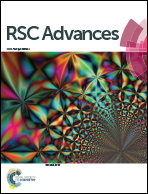Nanofiber mats electrospun from composite proton exchange membranes prepared from poly(aryl ether sulfone)s with pendant sulfonated aliphatic side chains
Abstract
A series of cardo poly(aryl ether sulfone) copolymers bearing pendant sulfonated aliphatic side chains were synthesized and electrospun into nanofibers. The sulfonated poly(aryl ether sulfone) nanofibrous mats were filled with appropriate amounts of Nafion solution. The composite membranes showed significantly reduced swelling and excellent mechanical properties as well as appropriate proton conductivity. These membranes in particular exhibited much lower methanol permeability, in the range of 10−7 cm2 s−1, and higher selectivity, at about 105 S s cm−3, than did Nafion 117 in our experiments. The results show that the fabricated nanofiber-based composite membranes can be used as a promising proton exchange membrane for direct methanol fuel cell applications.


 Please wait while we load your content...
Please wait while we load your content...